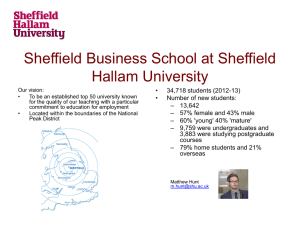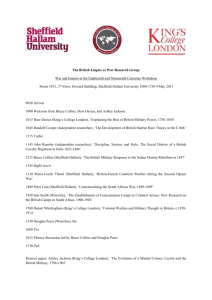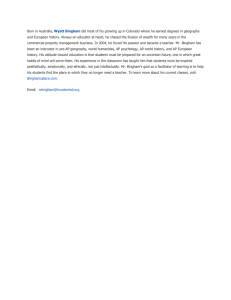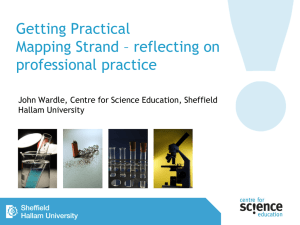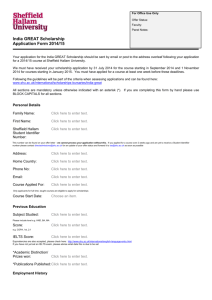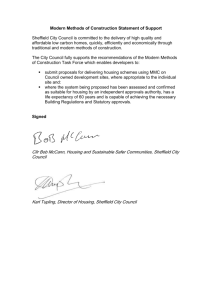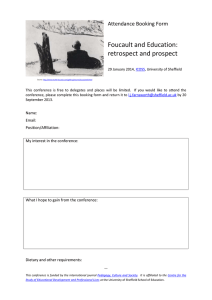Learning Outcomes and Assessment Criteria
advertisement
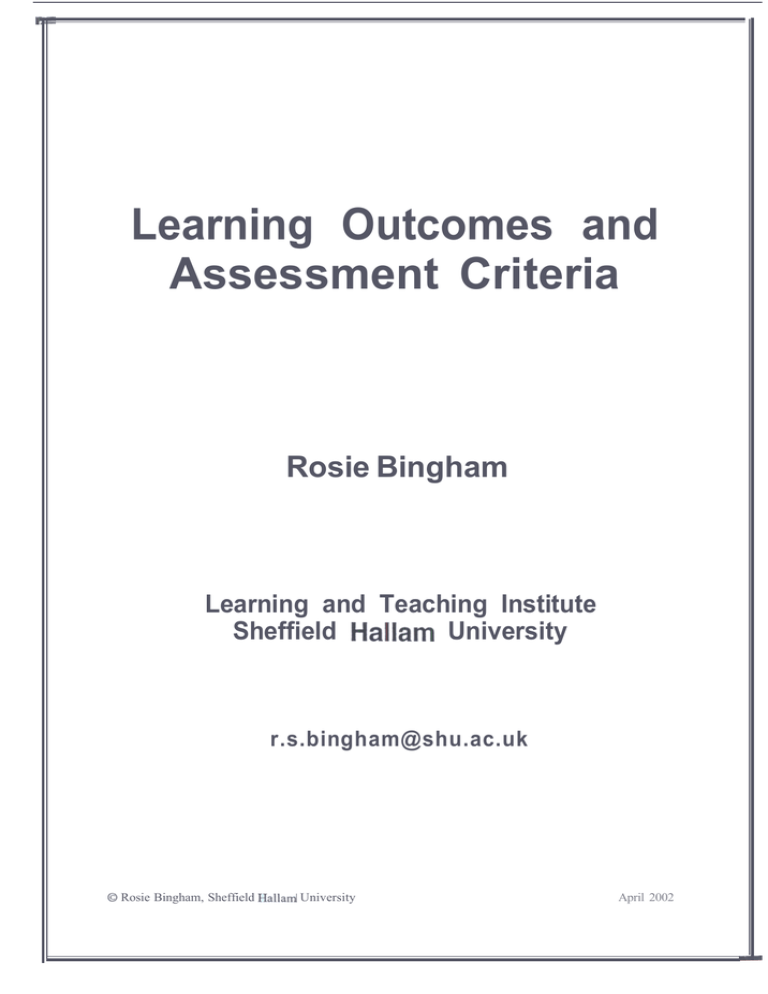
Learning Outcomes and Assessment Criteria Rosie Bingham Learning and Teaching Institute Sheffield Hallam University r.s.bingham@shu.ac.uk 0 Rosie Bingham, Sheffield Hallam University April 2002 Learning outcomes for the day..... Group members will be able to... . . . . . . . . . . . ?? ?? ?? ?? discuss the benefits and issues around developing/using learning outcomes and assessment criteria identify good practice in writing and using learning outcomes and assessment criteria write appropriate learning outcomes and assessment criteria consider any implications for their own practice 0 Rosie Bingham, Sheffield Hallam University April 2002 QAA model I 4 PDP* (Personal Development Planning) Intended Learning Processes that Outcomes enable outcomes to be achieved 0 Rosie Bingham, Sheffield Hallam University I Transcripts Outcomes actually achieved April 2002 ~~~ What are we trying to deal with? Coherence ?? (in design and student experience) ?? Level (of academic study) ?? Standards (student expected to meet ) We need to be: Educationally ‘sound’ ?? Explicit ?? Accountable ?? plus a whole raft of other areas . . . . . . . . . ..eg ?? ?? ?? ?? efficient and effective feedback for learning autonomous learners employability 0 Rosie Bingham, Sheffield Hallam University @ April 2002 Module planning Programme Specification I 7 ~~~- Learning Outcomes (What do I want the students to know, do and understand?) Assessment criteria Learning and teaching strategy (What methods will best help students achieve the learning outcomes?) - Standards I (How will I know if the student has achieved the learning outcomes - and how well?) Assessment strategy (What method(s) of assessment is best suited to students demonstrating their achievement of the learning outcomes?) 0 Rosie Bingham, Sheffield Hallam University April 2002 . . L :. .. .. .. .. . i f 8 s 0 Tips for writing learning outcomes . Keep to a manageable number - most modules have between 5 and 9 . You may not get them right first time - you may need to re-visit them as you develop teaching, learning, and assessment/feedback strategies. 0 Each outcome should be written at a pass level - not what you would expect form the highest achiever ? Make sure they are expressed at the appropriate level (see SHU LOS). ? Look at the balance between intended subject, personal and professional learning outcomes. Does this reflect what your module is about? Make sure your learning outcomes relate to overall programme outcomes. Can they be assessed? Are all your learning outcomes of equal importance? Determine what are essential, useful and optional. How will your students know? ? As you are developing learning outcomes, think about how you would know if a learner had achieved them ie the possible assessment method and criteria. Could your typical learner achieve the outcomes within the timescale? You could ask your previous learners what outcomes they identify/value. Ask colleagues if they understand what your learning outcomes are about Consider the relevant context - ie where your module fits into what learners have done before and what they will progress to Try to avoid: ? evaluative words eg “good” and “adequate” - they are assessment criteria ? ambiguous verbs such as “understand”, ” know”, “be aware” and “appreciate”. What level of ‘understanding’ do you mean? . educational jargon - students and others will need to use them ? references to the process by which the learning takes place eg “undertake a project” suggests it is actually the ability to plan and implement a project which you want the student to learn. ? long lists of separate outcomes which are variations of the same outcome. ? learning outcomes which are not easily assessed . referring to specific information in learning outcomes eg particular theories and techniques. These are included as content. ? learning outcomes which are too broad (they will be unassessible) or too narrow (leads to over-detailed and cumbersome lists). 0 Rosie Bingham, Sheffield Hallam University April 2002 A drive to develop: ?? holistic and coherent learning experience ?? standards and expectations ?? reliability, validity and consistency of the assessment process ?? accountability and transparency ?? efficiency and effectiveness, for students and tutors ?? feedback t o improve and develop student learning ?? student skills - to foster autonomous learners 0 Rosie Bingham, Sheffield Hallam University April 2002 Assessment criteria Students’ assessed work may be: ?? ?? ?? Norm-referenced - judges student work on the basis of their performance in relation to each other. Criterion-referenced - judges student work on the basis of their perFormance in relation to clearly stated criteria. lpsative - judges student in relation to his or her own previous performance. 0 Rosie Bingham, Sheffield Hallam University April 2002 Main questions about criteria: Do they enable students to know what they need to do to achieve the learning outcomes? ?? How will students (and others) know what they need to do to achieve a particular grade or mark? ?? 0 Rosie Bingham, Sheffield Hallam University April 2002 KEY FEATURES OF ASSESSMENT CRITERIA Assessment criteria should: ?? relate closely to the unit Learning .Outcomes, describing those aspects of the Learning Outcome which will be assessed ?? indicate what is required at a pass level, in a positive way ?? help students know what they need to do ?? help students understand what you expect at differing levels of achievement ?? be understandable to all stakeholders ?? be manageable in number ?? be distinct from each other ? be seen as an indication of achievement .rather than an exact measurement. It should be clear to tutors, students and other stakeholders, how and why marks/grades have been awarded, and that they have been awarded fairly. Open, fair and justifiable 0 Rosie Bingham, Sheffield Hallam University April 2002 Some issues raised by students include: mixed messages about what to do ?? ?? the need to second guess what’s in the tutor’s mind ‘fairness ?? ?? marks and feedback not relating to each other ?? not knowing which aspects of their work were good and which weren’t (eg a mark of 60%, but which 60% was good and which 40% was weak)? ?? not knowing what to do to improve 0 Rosie Bingham, Sheffield Hallam University April 2002 When developing criteria, you might find it helpful to think of them in terms of a flow chart, linking one stage to the next: - ifarf here: 1. Learning Outcome i statement If what a &dent ;hould know, lo or Jnderstand 3y the end of :he unit, a student should be sble to.. . . . . . The critical question is: Where do you want the student to get to? For example By the end of the unit, a student shoulc be able to.... locate and select from information sources (Level 1) Assessment CI ). Pass/threshold desczptor zvel ?ria L statement of the ypical pass equirement, in elation to the -earning Iutcomes L description of what the ;tudent must do to achieve I particular grade/mark against the assessment xiterion -or a typical pass he student fvill... . . . . . n order to achieve a larticular mark/grade (eg degree classification) the student’s work will.. . . . . The critical question is: On what basis will you judge whether they’ve got there? The critical question is: A/hat must they do to get there, ie to meet the criterion? The critical question is: Student work will be judged on...... For a typical pass, the student will . . . . . In order to achieve a 1,2.1, 2.2,3rd, student’s work will . . . Assessment Criterion 1 statement of Yhich aspects of ;tudent work will )e judged, in *elation to the -earning 3utcomes Student work will 3e judged on I . . . . . . . the range of information sources and the relevance of material selected for their needs locate the main sources of information and select those most relevant to their own needs. 4. Differentiated descrietors How will you know how well they have got there? 1 st - locate a wide range of sources, identifying appropriateness of sources for own needs. Select and justify, making explicit, their choices, 2.2 - locate a wide range of sources and select those most relevant, in relation to own need. Justify, making explicit, their choices 2.2 - locate a range of sources and select those most relevant, clearly identifying own needs 3rd - locate main sources and select those most relevant to OWI needs below 40% - limited sources located. lnappropria te or inaccurate selection 0 Rosie Bingham, Sheffield Hallam University April 2002 Areas to consider How many criteria will you have? ?? How many grades of achievement will you have? ?? How will you relate them to the Learning Outcomes? ?? How will you avoid telling the student what to do? ? ?? How will you avoid writing criteria which could restrict or restrain students? ?? Weighting criteria ?? How will you ensure a holistic approach? ?? Exam criteria? 0 Rosie Bingham, Sheffield Hallam University April 2002 Tips for developing grids: ? ? ? ? ? ? It takes time - to articulate your thoughts, to select appropriate and meaningful language, to clarify the progression from one grade to another, and to check out understanding with others. Never the less, it is a valuable and important exercise. It helps to start by developing the criteria for the 40% column what is the minimum standard required to pass? Once this is articulated, you can build up and down the columns. Some staff find it easier to next articulate the 70%+ level. Phrase the 400/dpass descriptor in positive terms. Words such as ‘inadequate’, ‘limited’, ‘inaccurate’ generally describe failing work. Tutors have found it useful to create grids with a colleague(s) discussion helps articulation of difficult ideas. As you move up the grades, avoid introducing new criteria into the descriptors. The main aspects of the criterion should follow up the levels, with an increasing demand in that particular aspect The following are some examples of ways you could move up the levels: ? Increasing the degree of autonomy required eg the level of independence or decision-making needed, initiative ? Broadening the situation/context in which the student applies the learning eg a pass might be unit-specific, higher grades might draw on wider experiences/sources ? Increasing the range/number of elements you expect the student to use eg using a wider range of presentation techniques, combining more problem solving techniques, using a combination of skill elements Q Rosie Bingham, Sheffield Hallam University April 2002
